warning light AUDI A8 2013 Owners Manual
[x] Cancel search | Manufacturer: AUDI, Model Year: 2013, Model line: A8, Model: AUDI A8 2013Pages: 318, PDF Size: 79.34 MB
Page 220 of 318

218 Cleaning and protection
This also applies to cleaning headlights
and painted bumpers. Remember: the
closer the nozzle is to the surface of the
material, the greater the stress on the ma
terial.
Caring for vehicles with matte finish
paint
Ap plies to vehicles: with matte fi nish pa in t
Vehicles with matte finish paint require spe
cial care due to the characteristics of the
paint.
Washing by hand
To avoid damaging the paint when washing,
first remove dust and large particles from
your vehicle. Insects, grease spots and finger
prints are best removed with a
special cleaner
for matte finish paint.
Apply the product using a microfiber cloth . To
avoid damaging the paint surface, do not use
too much pressure .
Rinse the vehicle thoroughly with water . Clean
the vehicle starting at the top and working to
ward the bottom using a
neutral shampoo
and a soft microfiber cloth . Stop frequently to
rinse the cloth thoroughly .
Clean the wheels and sill panels last. Use a
clean
sponge on these areas.
Rinse the vehicle thoroughly again and let it
air dry. If there are any water spots, they can
be removed using a
leather cloth.
Clean again with the special cleaner for matte
finish paint
if necessary.
Removing stubborn dirt
Bird droppings or tree sap
are best removed
with plenty of water and a microfiber cloth.
You should rinse off
gasoline residue immedi
ately with plenty of water.
_& WARNING
- Wash your vehicle only when the ignition
is switched off to reduce the risk of a
crash. -
Always read and heed all WARNINGS and
other information ¢
page 215.
@ Note
-Do not treat vehicle parts painted with
matte finish paint using polishing mate
rials or hard wax. These products could
cause damage to the appearance or sur
face that cannot be repaired.
- Never use protective wax. It can destroy
the matte finish effect.
- Do not place any stickers or magnetic
signs on vehicle parts painted with
matte finish paint. The paint could be
damaged when the stickers or magnets
are removed .
- To prevent paint damage, do not wash
the vehicle in direct sunlight.
- To prevent damage to the paint surface,
do not use insect removal sponges,
rough kitchen sponges or similar items.
- You should remove debris (such as in
sects) from the headlight lenses on a
regular basis, for example when refuel
ing your vehicle . Only clean the head
lights using a wet cloth or sponge, never
a dry one. Cleaning with soapy water is
recommended.
(D Tips
For more information on special cleaning
products designed for matte finish paint,
seeyourAudidea~~
' Sensors and camera lenses
- Remove snow with a hand brush and remove
ice with a de-icing spray that does not con
tain solvents.
- Clean the sensors (adaptive cruise control*,
parking system*) with a cleaning solution
that does not contain solvents and a soft
cloth.
- Dampen the camera lens with a household alcohol-based glass cleaner, and then wipe
the lens clean with a dry cloth . The area in
front of the camera lens is normally cleaned
by the windshield wipers (lane assist*) or .,.
Page 221 of 318

headlight washer system (night vis ion as
sist*) .
If the area is heavily soi led, you can
clean it with glass clean ing agent and a soft,
dry cloth.
(D Note
- If you wash your vehicle with a pressure
washer,
- make sure there is enough d istance to
sensors in the rear bumper .
- do not clean the camera lenses and the area around them with the pressure
washer.
- Never use warm or hot water to remove
snow or ice from the camera lens . Th is
could cause the lens to c rac k.
- Neve r clean the came ra lens w it h abra
s ive p roducts.
Waxing and Polishing
Waxing
A good wax coat ing protects the ve hicle pa int
to a large extent aga inst the environmen tal
factors listed under
r::o page 215, Washing and
even against slight scratches .
You can use a liquid ca r wax to p rotect your
pa int as soo n as o ne week after your veh icle
h as been de livered .
Even if you regular ly use a
waxing process in
automatic ca r washes, we recommend t hat
you ma nually app ly a coat of wax to give the
pa int extra protec tion , particula rly if wate r no
l onge r beads on the clean paint .
P rotect p lastic body pa rts with ca r wax i n the
same way as the vehicle body.
During warm weather dead insects tend to
collect on the front bumper and on the for
ward area of the hood . They a re much easier
to remove from pai nt tha t is waxed
often.
Polishing
Poli sh your vehicle only if the pa int has lost its
shine and the gloss cannot be brought back
with wax .
Cleaning and protec tion 219
If the po lish used does not contain p reserva
tive compounds, the paint must be waxed af
terwards.
_& WARNING
A lways read and heed all WARNINGS and
other information
r::opage 215 .
([) Note
Do not use car wax on
- matte or anodized meta l trim
- ru bber or ru bber- lik e t rim.
Trim strips
Metal trim needs special care.
For environmental reasons, Audi fabric ates
the bright t rim strips and trim p ieces from
pure chromium-free al uminum .
Dirt and marks on the trim strips shou ld be
removed w ith a
pH-balanced cleaning agent
(do not use a chrome cleane r) . Aud i dealers
carry clean ing produc ts which have been test
ed fo r use on your vehicle and are not ha rmfu l
to the environment.
T o avoid co rrosion on the exter ior trim st rips,
o nly a pH-ba lanced solu tion should be used
for the windsh ield washer.
_& WARNING
A lways read and heed all WARN INGS and
o ther in formation
r::o page 215 .
Plastic and vinyl
Plastic needs special care.
Use a clean , damp cloth or sponge to remove
dust and light s urface di rt . For other soil, use
a lukewa rm all-p urpose cleaning so lution or a
mild saddle soap for v inyl tr im . Remove wate r
spots and traces of soa p wi th a cle an, d amp
clo th or sponge. Use a clean, so ft cloth to rub
dry .
G rease , ta r or oil stains can be removed w it h a
cl ea n clot h or sponge soake d wit h all- purpose .,.
•
•
Page 223 of 318
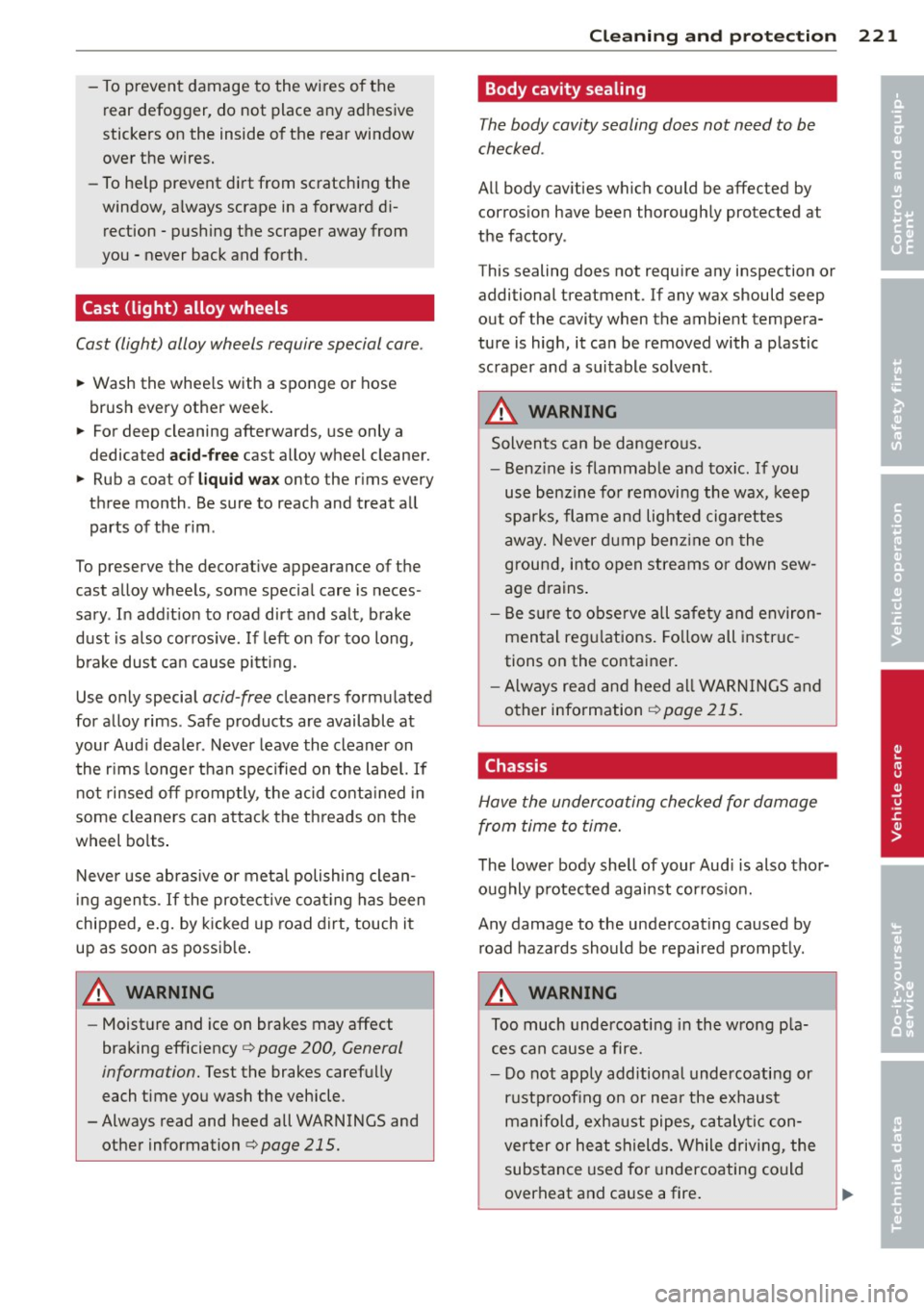
-To prevent damage to the wi res of the
rear defogger, do not place any adhesive
stickers on the inside of the rear window
over the wires.
- To he lp prevent dirt from scratching the
window, always scrape in a forward di
rection - pushing the scraper away from
you - never back and forth .
Cast (light) alloy wheels
Cast (light) alloy wheels require special care.
~ Wash the wheels with a sponge or hose
brush every other week.
~ For deep cle aning afterwa rds, use only a
dedica ted
acid -free cast alloy wheel cleaner.
~ Rub a coa t of liquid wax on to the r ims every
three month . Be sure to reach and treat all
parts of the rim .
To preserve the decorat ive appearance of the
cast alloy wheels , some special care is neces
sary . In add it ion to road dirt and salt , brake
dust is also corros ive. If left on for too long,
b rake dust can cause pi tting.
Use only specia l
acid-free cleaners formulated
for alloy rims. Safe products are available at
your Aud i deale r. Never leave the cleaner on
the r ims longe r than spec ified on the label. If
n o t rinsed off promptly , the acid co nta ined in
some cleaners can attack the th reads on the
wheel bo lts .
Never use abras ive or metal polishing clean
in g agents. If the prote ctive coat ing has been
chipped, e .g. by k icked up road d irt, touch it
up as soon as possib le .
A WARNING
- Moist ure and ice on brakes may affect
braking efficiency
i:> page 200, General
information.
Test the brakes carefully
each time you wash the vehicle .
- Always read and heed all WARNINGS and other information
c> page 215.
Cleaning and protec tion 221
Body cavity sealing
The body cavity sealing does not need to be
checked .
All body cav ities which could be affected by
corros io n have been thoroughly protected at
the factory .
This sealing does not require any inspection or additional treatmen t. If any wax should seep
out of the cavi ty when the ambie nt tempera
ture is high, it can be removed with a p lastic
scraper and a su itable solvent .
A WARNING
Solvents can be dangero us.
- Benz ine is flammab le and toxic. If you
use benz ine fo r removing the wax , keep
sparks, flame and lig hted cigarettes
away. Never d ump ben zine on the
grou nd, into open streams or down sew
age drains .
- Be s ure to obse rve a ll safe ty and environ
men tal reg ulations. Fo llow all instruc
tions on the container.
- Always read and heed a ll WAR NIN GS and
o ther information ¢
page 215.
Chassis
Have the undercoating checked for damage
from time to time.
The lower body shell of your Aud i is also thor
oughly p rotec ted against cor ros io n.
Any damage to the undercoat ing caused by
road hazards should be repaired promptly .
A WARNING
Too much undercoating in the wrong pla
ces can cause a fire.
- Do not apply additional undercoating or
rustp roofing on or nea r the exhaust
manifold, exhaust pipes, catalyti c con
ver ter or he at shields. While driving, the
substance used fo r undercoating co uld
overheat and cause a fire.
•
•
Page 224 of 318
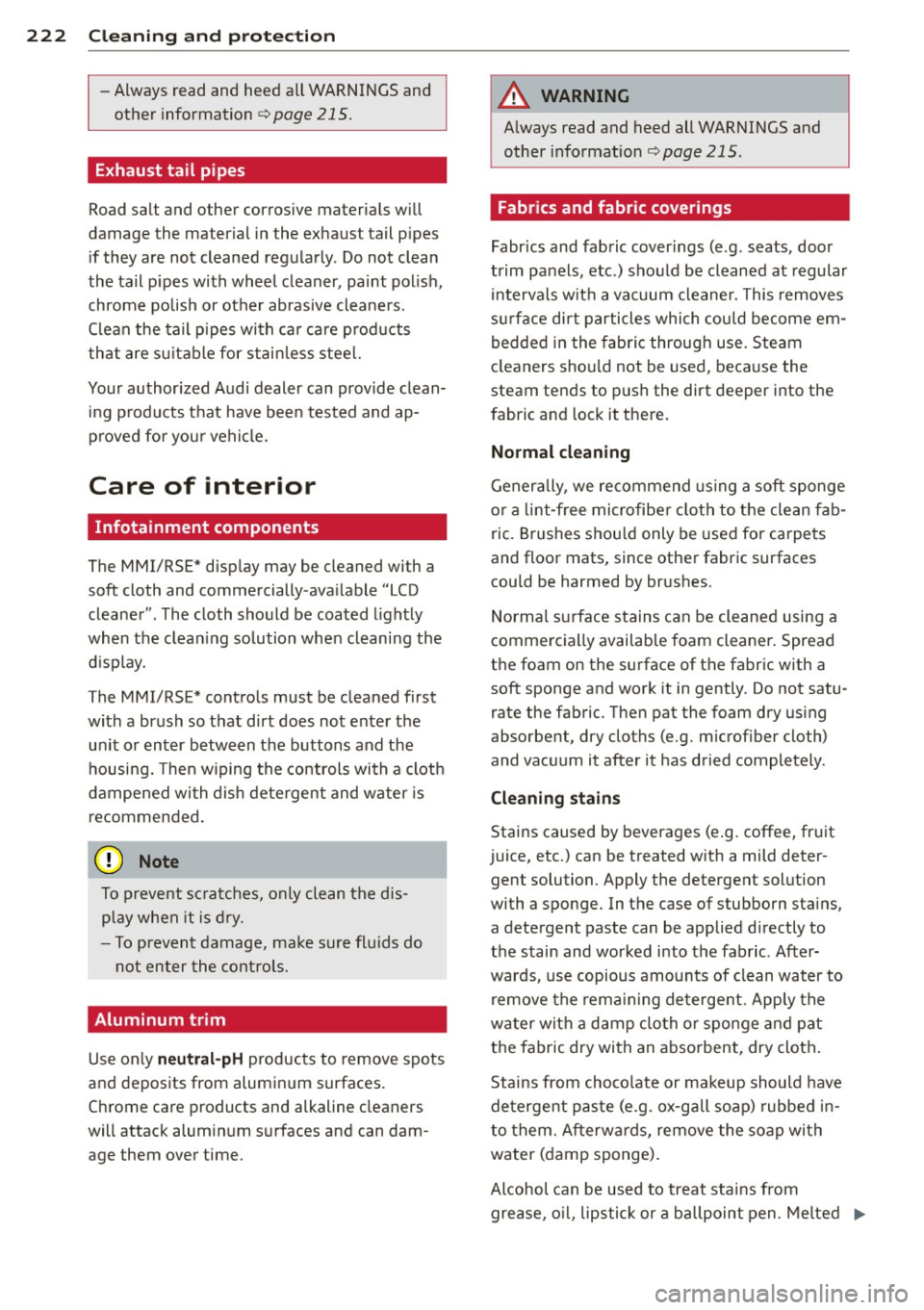
222 Cleaning and protec tio n
-Always read and heed all WARNINGS and
other information ¢
page 215.
Exhaust tail pipes
Road salt and other corrosive materials will
damage the material in the exhaust tail pipes
if they are not cleaned regularly . Do not clean
the tail p ipes with wheel cleaner, paint pol ish,
chrome po lish or other abrasive cleaners.
C lean the tail p ipes with car ca re p roducts
that are su itable for stain less stee l.
Your author ized Audi dealer can provide clean
ing p roducts that have been tested and ap
p roved fo r you r vehicle.
Care of interior
Infotainment components
The MMI/RSE* display may be cleaned with a
soft cloth and commercially-ava ilable "LCD
cleaner" . The cloth should be coated lightly
when the clean ing solution when cleaning the
d isplay.
The MMI/RSE* contro ls must be cleaned first
with a brush so t hat dirt does not ente r the
un it or enter between the buttons and the
housing. Then wiping the controls with a cloth
dampened with dish detergent and water is recommended.
CJ) Note
To prevent sc ratches, only clean the dis
play when it is d ry.
- To prevent damage, ma ke sure fluids do
not enter the controls.
Aluminum trim
Use only n eutral-pH products to remove spots
and deposits from aluminum surfaces.
Chrome ca re products and alkaline cleaners
will attack aluminum s urfaces and can dam
age them over time.
A WARNING
A lways read and heed all WARNINGS and
other information¢
page 215.
Fabrics and fabric coverings
Fabrics and fabric cover ings (e .g. seats, door
trim panels, etc.) should be cleaned at regular i ntervals w ith a vacuum cleaner. This removes
su rface di rt particles which could become em
bedded in the fabric through use. Steam
cleaners should not be used, because the
steam tends to p ush the dirt deeper into the
fabric and lock it there.
Normal clean ing
Generally, we recommend using a soft sponge
o r a lint-free microfiber cloth to the clean fab
ric. Brushes shou ld only be used for carpets
and floor mats, since other fabric surfaces
could be harmed by brushes.
Norma l su rface stains can be cleaned using a
commercially available foam cleaner . Spread
the foam on the s urface of the fabric with a
soft sponge and work it in gently. Do not satu
rate the fabric. Then pat the foam dry using
absorbent, dry cloths (e.g. m icrof iber cloth)
and vacuum it after it has dried completely.
Cle anin g sta ins
Stains caused by beverages (e .g. coffee, fruit
juice, etc.) can be treated with a mild deter
gent solution. Apply the detergent solution
with a sponge. In the case of stubborn stains, a detergent paste can be applied directly to
the stain and worked into the fabric. After
wards, use copious amounts of clean water to
remove the rema in ing deterge nt. Apply the
water wit h a damp clo th or sponge and pat
the fabric dry with an abso rbent, dry cloth .
Stains from choco late or makeup should have
detergent paste (e.g. ox-gall soap) rubbed in
to them. Afterwa rds, remove the soap with
water (damp sponge) .
Alcohol can be used to treat stains from grease, o il, lipstick or a ballpoin t pen . Melted ..,.
Page 227 of 318
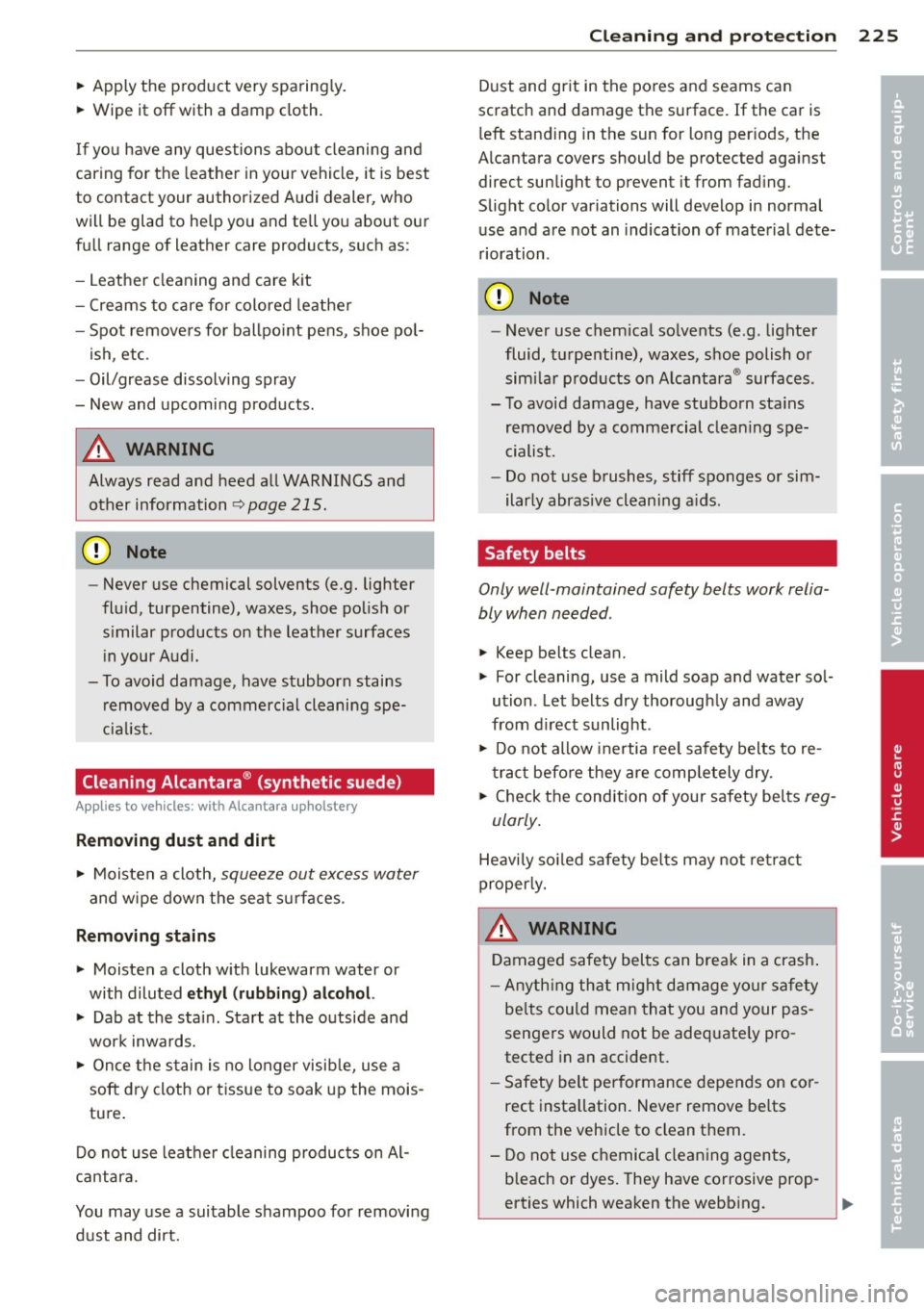
~ Apply the product very sparing ly .
~ Wipe it off with a damp cloth.
If you have any questions abo ut cleaning and
caring for the leather in your vehicle, it is best
to contact your authorized Audi dealer, who
will be glad to help you and tell you about our
fu ll range of leather care products, such as:
- Leather cleaning and care kit
- Creams to care for colored leathe r
- Spot removers for ballpo int pens, shoe pol-
ish , etc.
- Oil/grease dissolv ing spray
- New and upcoming products.
A WARNING
Always read and heed all WARNINGS and other information
~ page 215.
CD Note
- Never use chemical solvents (e.g. lighter
flu id, turpentine), waxes, shoe polis h or
s imilar products on the leather surfaces
i n your Audi.
- To avoid damage, have stubborn stains removed by a commerc ial cleani ng spe
cia list .
Cleaning Alcantara ® (synthetic suede)
Appl ies to vehicles : wit h Alcantara upholstery
Removing dust and dirt
~ Moisten a cloth, squeeze out excess water
and wipe down the se at su rfaces .
Removing stains
~ Moisten a cloth w ith lukewarm water or
with diluted ethyl (rubb ing) alcohol.
~ Dab at the stain. Start at the outside and
work inwa rds.
~ Once the s tain is no longer visib le, use a
soft d ry cloth or t issue to soak up the mois
tu re .
D o not use leather cleaning produc ts on Al
cantara.
You may use a suitable shampoo fo r removing
dust and dirt.
Cleaning and protec tion 225
D ust and gr it in the po res and seams can
scratch and damage th e surface. If the car is
l eft stand ing in the sun for long per iods, the
A lcantar a cover s should be protected aga inst
direct sunlight to prevent it from fad ing.
Slight co lor variations will develop in normal
use a nd are not an indication of mate rial dete
rioration .
CD Note
- Never use chemical so lvents (e.g . lighter
fluid, tu rpenti ne), waxes, shoe polish or
simi lar p roducts on A lcantara ® surfaces .
- T o avoid damage, have stubborn sta ins
removed by a comme rcial clean ing spe
cialist.
- Do not use b rushes, stiff sponges or sim
ilarly abrasive cleani ng a ids.
Safety belts
Only well -maintained safety belts work relia
bly when needed .
~ Keep belts clean.
~ For cleaning, use a mild soap a nd wate r so l
ution . Let belts dry thorough ly and away
from d irect sunlight .
~ Do not allow i nertia ree l safety belts to re
tract before they are comp letely dry.
~ Check t he condition of your safety belts reg
ularly .
Heavi ly so iled safety be lts may not ret ra ct
properly.
A WARNING ~
D amaged safety belts can break in a crash .
- Anyth ing th at m ight damage yo ur safety
be lts could mean tha t you and your pas
sengers would not be adequate ly pro
tected in an accident.
- Safety belt performance depends on cor
rect insta llation . Never remove be lts
from the vehicle to clean them.
- Do not use chemical cleaning agents,
b leach or dyes. They have corrosive prop
erties which weaken the webb ing .
•
•
Page 234 of 318
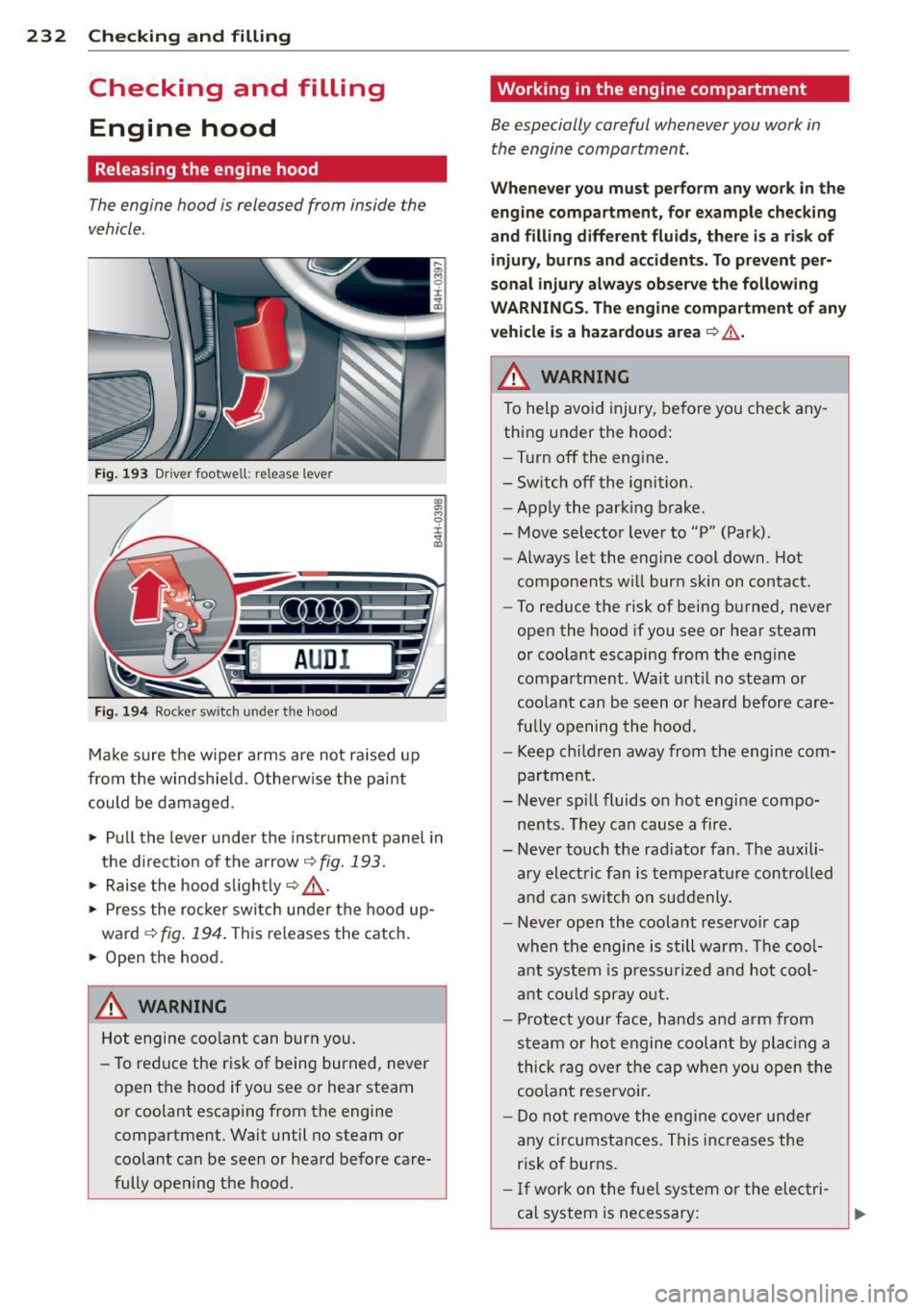
232 Checking and filling
Checking and filling Engine hood
Releasing the engine hood
The engine hood is released from inside the
vehicle .
Fig. 193 Driver foo twell: release lever
AUD I
Fig. 194 Rocker switch un der the hood
Make sure the wiper arms are not raised up
from the windshield. Otherwise the paint
could be damaged .
.,. Pull the lever under the instrument panel in
the direction of the arrow
~ fig. 193.
.,. Raise the hood slightly~,&. .
... Press the rocker switch under the hood up
ward
~ fig. 194. This releases th e catch.
... Open the hood.
&_ WARNING
Hot engine coolant can burn you.
- To reduce the risk of being burned, never
open the hood if you see or hear steam
or coolant escaping from the engine compartment . Wait until no steam or
coolant can be seen or heard before care
fully opening the hood .
' Working in the engine compartment
Be especially careful whenever you work in
the engine compartment.
Whenever you must perform any work in the
engine compartment, for example checking
and filling different fluids, there is a risk of injury, burns and accidents. To prevent per
sonal injury always observe the following
WARNINGS. The engine compartment of any
vehicle is a hazardous area
~ ,&. .
A WARNING
To help avoid injury, before you check any
thing under the hood:
- Turn off the engine.
- Switch off the ignition .
- Apply the parking brake.
- Move selector lever to "P" (Park) .
- Always let the engine cool down. Hot
components will burn skin on contact.
- To reduce the risk of being burned, never
open the hood if you see or hear steam
or coolant escaping from the engine
compartment. Wait until no steam or
coolant can be seen or heard before care
fully opening the hood.
- Keep children away from the engine com
partment.
- Never spill fluids on hot engine compo
nents . They can cause a fire .
- Never touch the radiator fan. The auxili
ary electric fan is temperature controlled
and can switch on suddenly .
- Never open the coolant reservoir cap
when the engine is still warm . The cool
ant system is pressurized and hot cool
ant could spray out.
- Protect your face, hands and arm from
steam or hot engine coolant by placing a
thick rag over the cap when you open the
coolant reservoir.
- Do not remove the engine cover under
any circumstances. This increases the
risk of burns.
- If work on the fuel system or the electri
cal system is necessary:
Page 237 of 318
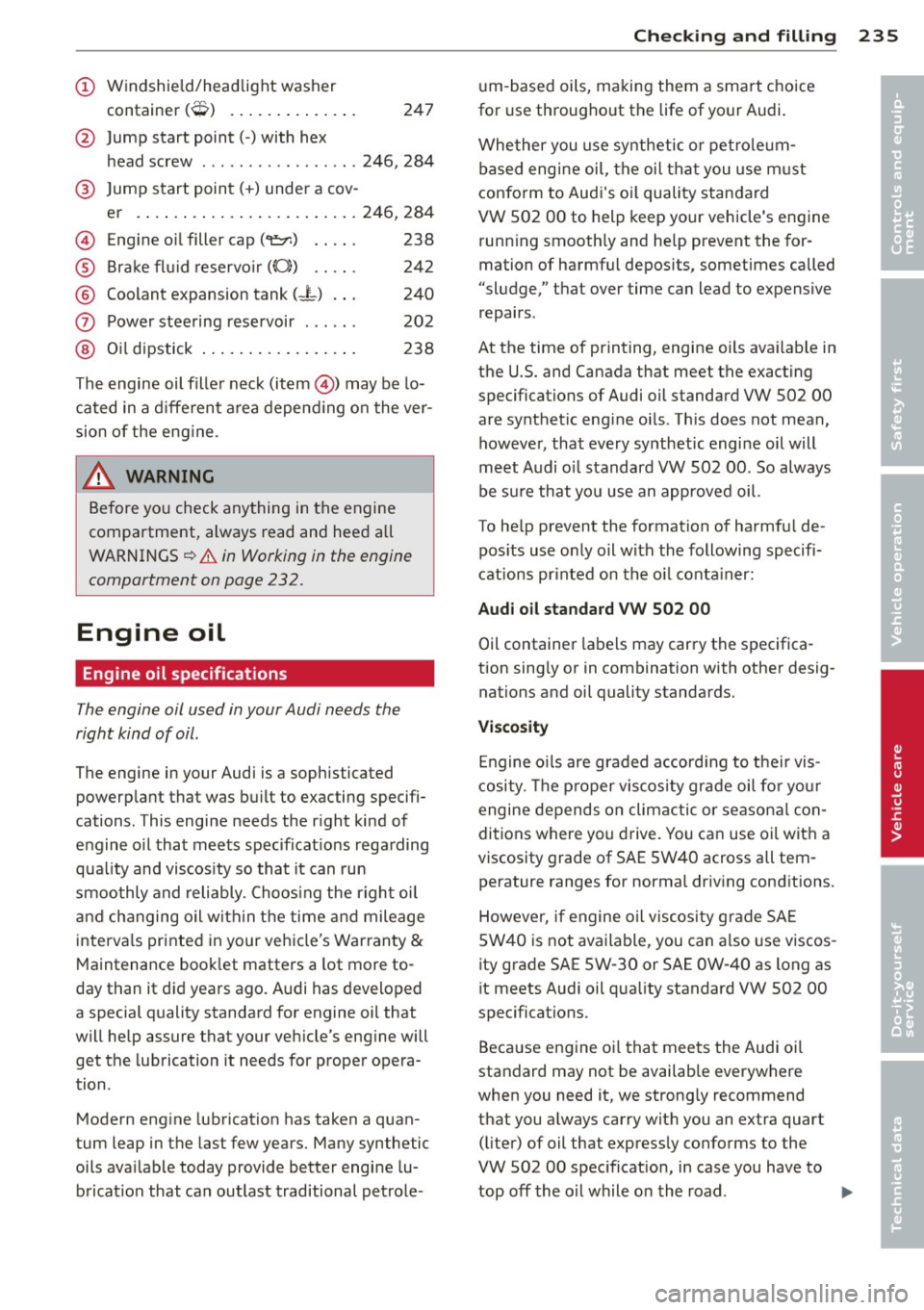
(!) Windshield/headlight washer
t .
(~ ) con ainer ,..., .. .... ... ... . . 247
@ Jump start point( -) with hex
h ead screw ............... .. 246, 284
® Jump start point( +) under a cov-
er . ..... .. ... .. ..... ... .. . 246, 284
@ Engine oil filler cap(~) . . . . . 238
® Brake fl uid reservo ir ((0)) . . . . . 242
® Coolant expansion tank (-L) . . . 240
0 Power steering reservoir . . . . . . 202
@ Oil dipstick . . . . . . . . . . . . . . . . . 238
The engine oil fille r nec k (item @) may be lo
cated in a d ifferent a rea depend ing o n the ver
sion of the eng ine .
A WARNING
Before yo u check any thing in the engine
compartment, always read and heed all
WARNINGS
~ &. in Working in the engine
compartment on page 232.
Engine oil
Engine oil specifications
The engine oil used in your Audi needs the
right kind of oil.
-
The engine in your Audi is a sophisticated
powerp lant that was bu ilt to exacting specifi
cations. This engine needs the r ight kind of
engine o il that meets specificat ions rega rding
qua lity and viscos ity so that it can run
smoothly and reliably . Choos ing the righ t oi l
and ch anging oil with in t he time and mileage
inte rva ls printed in your veh icle's Warranty
&
M aintenance book let matters a lot more to
day than it d id years ago. A udi has developed
a special quality standard for engine oil that
will he lp assure that your veh icle's eng ine will
get the lubrication it needs for prope r opera
tion .
M odern eng ine lubrication has taken a quan
tum leap in the last few years. Many synthetic
oils ava ilable today provide better engine lu
brication that can outlast traditional pet role -
Checkin g and fillin g 235
um -based oils, ma king them a smart cho ice
for use throughout the life of your Audi.
Whether you use sy nthetic o r pe trole um
based eng ine oil, the oil tha t you use m ust
confo rm to Aud i's oi l quality standard
VW 502 00 to help keep your vehicle's engine runn ing smooth ly and he lp prevent the for
mation of harmful deposits, sometimes called
"sludge," that over time can lead to expensive
repairs .
At the time of printing, engine oils ava ilab le in
the U.S. and Canada that meet the exact ing
specifications of Audi oi l standard VW 502 00
are synthet ic eng ine o ils . Th is does not mean,
howeve r, that every sy nthetic engi ne oil will
meet A udi o il standard VW 502 00 . So always
be s ure that yo u use an approved oil.
To he lp prevent the formation of harmfu l de
pos its use on ly o il wi th the following specifi
cat ions pr inted on th e oil conta iner:
Audi oil standard VW 502 00
Oil container labe ls may car ry the specifica
tion sing ly or in combination with othe r desig
nations and oil quality standards.
Viscosity
E ngine o ils are graded a ccord ing to the ir vis
cosi ty . T he p roper viscos ity grade oil fo r yo ur
engine depends on climactic o r seasona l con
ditions where yo u drive. You can use oi l wit h a
viscosity grade of SAE 5W40 across all tem
perature ranges for norma l driv ing cond itions.
However, if engine oil viscosity g rade SA E
5W40 is not available, you can also use viscos
ity grade SAE 5W -30 or SAE OW -40 as long as
it meets Audi oil q ua lity standard VW 502 00
specifications.
Because eng ine o il tha t meets the Audi oi l
standard may not be availab le everywhere
when you need it, we strong ly recommend
that you a lways carry wit h you an extra quart
( li ter) of oil that express ly conforms to the
VW 502 00 spec if icat ion, in case you have to
top off the o il while o n the road . .,..
•
•
Page 239 of 318
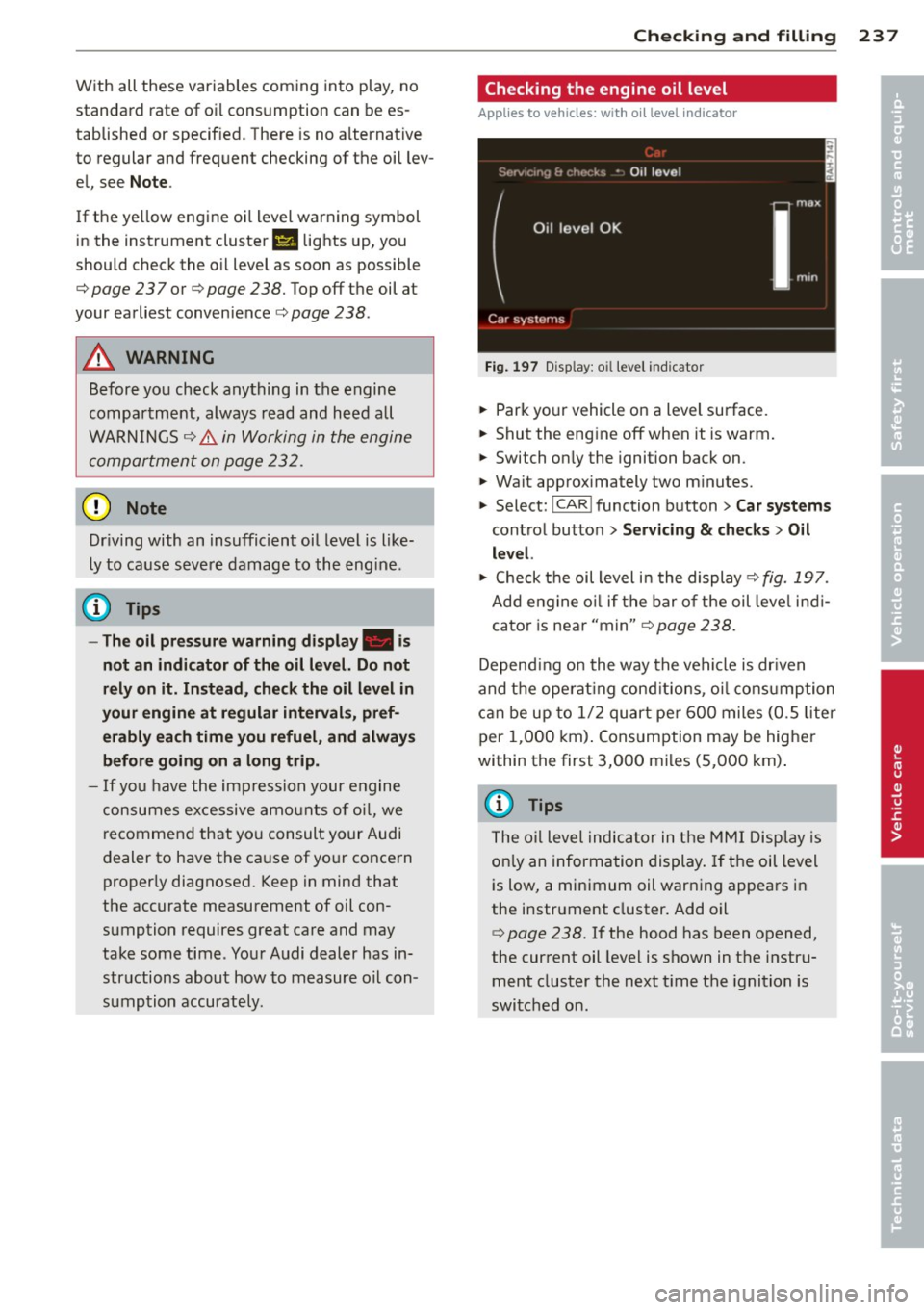
With all these variables coming into play, no
standard rate of oil consumption can be es
tablished or specified . There is no alternative
to regular and freq uent checking of the oi l lev
e l, see
Note .
If the ye llow engine oi l level war ning symbol
in the instrument cluster
II lights up, you
should check the o il level as soon as possible
¢
page 23 7 or ¢ page 238. Top off the oil at
your earliest convenience¢
page 238 .
.&_ WARNING
Before yo u check anything in the engine
compartment, always read and heed all
WARN INGS
¢ &. in Working in the engine
compartment on page 232.
0 Note
Dr iving with an insufficient oil level is like
ly to ca use seve re damage to the eng ine.
{1) Tips
- The oil pressu re warning display. i s
not an indicator of the oi l level. Do not
rely on it. Instead , check th e oil level in
your engine at regular interval s, pref
erably each time you refuel, and always before going on a long trip .
-If yo u have the impres sion your engine
consumes excessive amo unts o f oil, we
r ecommend that yo u consult your Audi
dealer to have the ca use of yo ur conce rn
proper ly diagnosed . Keep in mind that
the accurate measurement of oil con
sumption requires great care and may
take some time. You r Audi dealer has in
str uctions about how to measure o il con
sumption accurately.
Checkin g and fillin g 237
Checking the engine oil level
Applies to vehicles : wit h oil level indicator
Fi g. 1 97 Disp lay: o il leve l indicator
.,. Park yo ur vehicle on a level surface.
.,. Shut the eng ine off when it is warm .
.,. Switch on ly the ignition back on .
.,. Wait approx imately two m inutes.
.,. Select:
I CAR ! function button > Car systems
contro l butto n > Servicing & checks > Oil
level.
.,. Check t he oil level i n the display ¢ fig. 197.
Add eng ine o il if t he bar o f the oil leve l ind i
cator is near "min"¢
page 238.
Depend ing on the way the vehicle is dr iven
and t he ope rat ing cond it ions, oi l cons umption
c a n be up to 1/ 2 quart pe r 60 0 miles (0.S liter
per 1,000 km) . Cons umption may be higher
within the first 3,000 m iles (S,000 km) .
(D Tips
The o il leve l indic ato r in the MMI Disp lay is
on ly an informa tion display.
If t h e oil level
i s low, a minimum oil warn ing appears in
the instrument cluster. Add oil
¢
page 238. If the hood has been opened,
the current oil level is shown in t he instr u
ment cluster the next t ime the ignition is
swi tched on.
•
•
Page 243 of 318
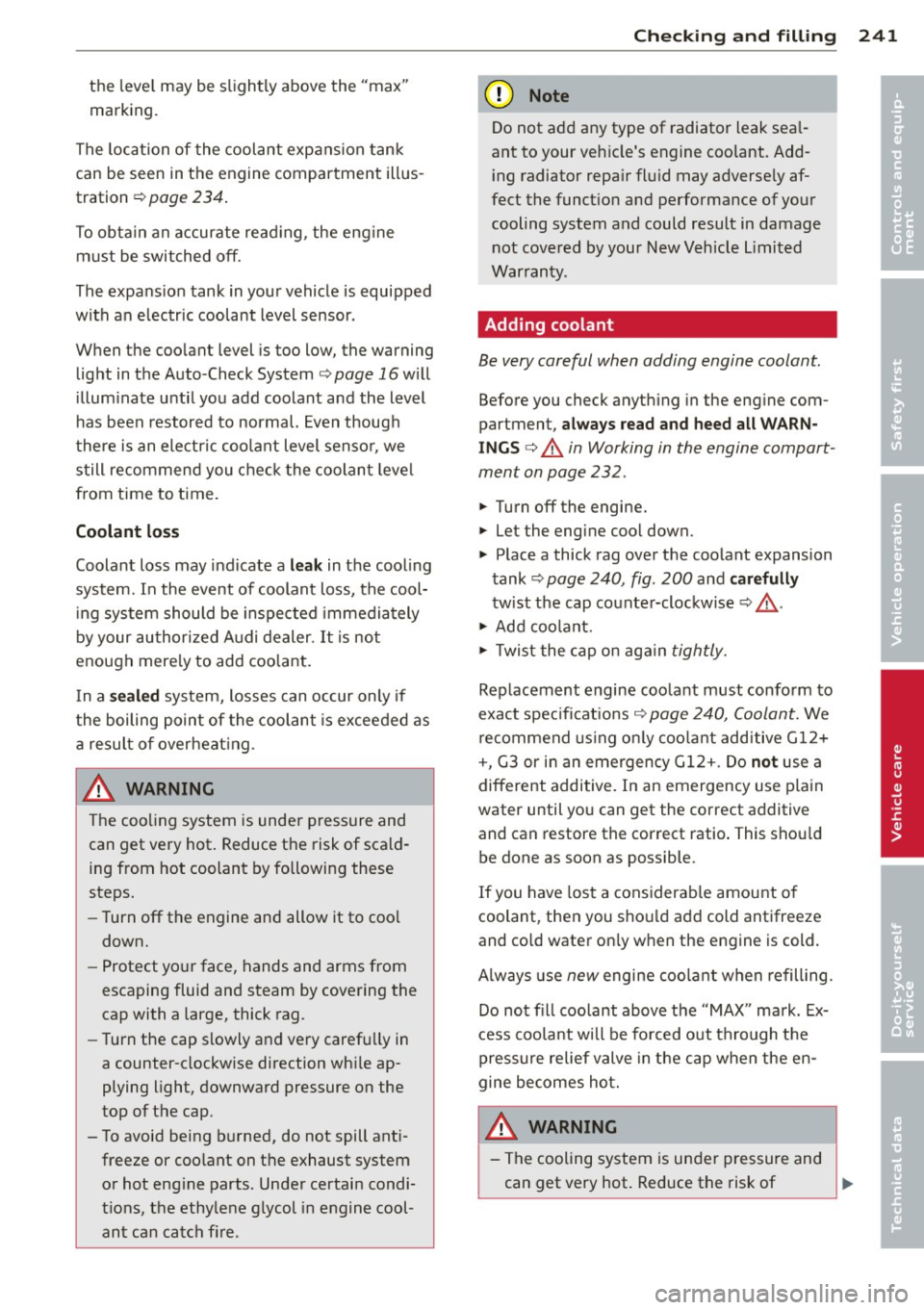
the level may be slightly above the "max"
marking .
The location of the coolant expansion tank
can be seen in the engine compartment illus
tration ¢
page 234.
To obtain an accurate reading, the engine
must be switched
off.
The expansion tank in your vehicle is equipped
with an electric coolant level sensor.
When the coolant level is too low, the warning
light in the Auto-Check System
¢page 16will
illuminate until you add coolant and the level
has been restored to normal. Even though
there is an electric coolant level sensor , we
still recommend you check the coolant level
from time to time.
Coolant loss
Coolant loss may indicate a leak in the cooling
system. In the event of coolant loss, the cool
ing system should be inspected immediately
by your authorized Audi dealer.
It is not
enough merely to add coolant.
In a
sealed system, losses can occur only if
the boiling point of the coolant is exceeded as
a result of overheating.
& WARNING
The cooling system is under pressure and
can get very hot. Reduce the risk of scald
ing from hot coolant by following these
steps.
- Turn
off the engine and allow it to cool
down.
- Protect your face, hands and arms from
escaping fluid and steam by covering the
cap with a large, thick rag.
- Turn the cap slowly and very carefully in
a counter-clockwise direction while ap
plying light, downward pressure on the
top of the cap.
- To avoid being burned, do not spill anti freeze or coolant on the exhaust system or hot engine parts . Under certain condi
tions, the ethylene glycol in engine cool
ant can catch fire .
Checking and filling 241
@ Note
Do not add any type of radiator leak seal
ant to your vehicle's engine coolant. Add
ing radiator repair fluid may adversely af
fect the function and performance of your
cooling system and could result in damage not covered by your New Vehicle limited
Warranty .
Adding coolant
Be very careful when adding engine coolant.
Before you check anything in the engine com
partment,
always read and heed all WARN
INGS ¢ & in Working in the engine compart
ment on page 232 .
.,. Turn off the engine .
.,. let the engine cool down.
.,. Place a thick rag over the coolant expansion
tank ¢
page 240, fig . 200 and carefully
twist the cap counter-clockwise ¢&_ .
.,. Add coolant.
.,. Twist the cap on again
tightly.
Replacement engine coolant must conform to
exact specifications ¢
page 240, Coolant. We
recommend using only coolant additive G12+
+, G3 or in an emergency G12+. Do
not use a
different additive. In an emergency use plain
water until you can get the correct additive
and can restore the correct ratio. This should
be done as soon as possible.
If you have lost a considerable amount of
coolant , then you should add cold antifreeze
and cold water only when the engine is cold.
Always use
new engine coolant when refilling.
Do not fill coolant above the "MAX" mark. Ex
cess coolant will be forced out through the pressure relief valve in the cap when the en
gine becomes hot.
A WARNING
- The cooling system is under pressure and
can get very hot. Reduce the risk of
II-
•
•
Page 244 of 318

24 2 Ch ecking and filling
scalding from hot coolant by following
these steps .
- Turn off the eng ine and a llow it to cool
down.
- Protect your face, hands and arms from escaping flu id and steam by cover ing
the cap with a large, thick rag .
- Turn the cap slowly and very carefully
i n a counter-clockwise direction while
apply ing l ight, downwa rd press ure on
the top of the cap .
- To avo id being burned, do not spi ll an
tifreeze or coolant on the exhaust sys
tem or hot engine parts . Under certain
conditions, the ethylene glyco l in en
gine coolant can catch f ire .
- Antifreeze is poisonous . Always store an
tifreeze in its or iginal container and we ll
out of the reach of children.
- If you drain the coolant, it must be
caught and safely stored in a proper con
tainer clear ly marked "poison".
@ Note
- Coolant po llutes the env ironment and
could cause an engine fire . Excess coo l
ant will be forced out through the pres
sure re lief valve in the cap when the en
gine becomes hot.
- If, in an emergency, only water can be
added, the correct ratio between water
and antifreeze
c::> page 240 must be re
stored as soon as possible .
@ For the sake of the environment
Drained coolant should not be re used. Al
ways dispose of used coolant while observ
ing all environmental regulat ions .
Radiator fan
The radiator fan switches on automatically by
itself
T he radiator fan is driven by the engine via the
V-be lt . The viscous clutch regulates the speed
of the fan accord ing to the temperature of the
coolant. An a
uxiliary electric radiator fan* switches on
and off depend ing on coolant temperature
and other vehicle operat ing condit ions .
After yo u sw itch the engine off, the aux iliary
f an can continue running for up to 10 minutes
- eve n wit h the ignit ion off. It can even switc h
on again later by itself
c::> &. , if
- t he tempe rature of the engine coo lant rises
due to the heat build -up from the engine in
the engine compartment, or
- the engine compa rtment heats up because
the vehicle is parked in i ntense sunlight.
_& WARNING
- To reduce the risk of personal injury nev
er touch the radiator fan.
- The auxiliary electric fan is temperat ure
controlled and can sw itch on suddenly
even when the engine is not running.
- The a uxiliary radiator fan sw itches on au
tomatically when the engine coo lant
reaches a certai n temperature and will
continue to run until the coolant temper
ature drops .
Brake fluid
Checking brake fluid level
The brake fluid level can be checked with a
quick glance.
F ig . 201 E ngin e compart men t: cover on the brake fluid
r eservo ir
Before you check a nyth ing in the engine com
partment,
always read and hee d all WARN
INGS c::> .&. in Working in the engine compart-
ment on page 232. .,..